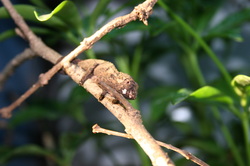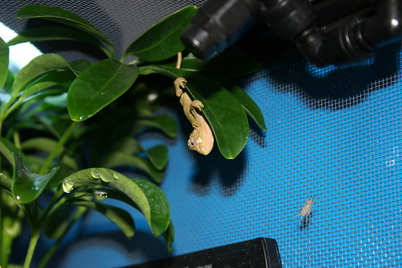Trioceros johnstoni

First described in 1901 this is arguably the most colourful of the three horned chameleons. The Johnston's chameleon is normally found anywhere from the Democratic Republic of Congo, Burundi, Rwanda and Uganda, usually found in montane highlands at elevations ranging from 1,000-2,500 meters above sea level. There are many superstitions regarding this chameleon in its homeland, including the idea that the blood from its tail will heal deafness, whereas in some places it is believed to be highly poisonous. The locals of Uganda call this chameleon Lukiga (for female) or Lukanjo (for male), and believe it is a blessing to find a pair mating.
As a chameleon hobbyist I have always drooled over pictures of Trioceros johnstoni, a chameleon that many consider to be "impossible" to keep successfully. Recently I acquired two captive hatched specimens, and hope to share my experiences with this species. We can only hope that one day this species will be established in captivity. I am by no means an expert on this species, but have put together all the knowledge I've aquired through research and experience to hopefully make an all in one care-sheet for this species. Feel free to contact me with any questions you may have that are not covered in this site using the contact tab.
Captive Care
Choosing Your Chameleon
A good percentage of Johnston's chameleons you will find (if you can find them!) will be wild caught. Meaning they will carry a heavy parasite load. WC Johnston's chameleons normally do not do well in captivity, but when available, captive hatched specimens are much hardier and are normally parasite free.
The Basics
Johnston's chameleons are considered "montane", meaning that they come from high altitudes, and are used to lower temperatures and high humidity. In captivity wild adults are less forgiving of mistakes. A daytime temperature of 72-78 degrees (about room temperature) is recommended, with a moderate night-time drop. An oscellating an that will mimic wind is recommend for adults, being that recreating their natural habitat is key for success. Females will most likely come in gravid so a laying bin is necessary. Wild females normally die shortly after laying, because it takes so much out of them. De-worming is optional, but many consider it more detrimental then the parasites themselves. The key to a healthy chameleon is to keep it as stress free as possible, and try to replicate its natural environment. (after all, chameleons live in harmony with parasites in the wild). Newly imported chameleons will need lots of water to keep hydrated, three to four mistings a day would be ideal. A misting system comes in handy with any chameleon species.
Housing
Adults can be housed in 18x18x36 screen cages, (although glass cages from Protean would work well) and should be housed singly, the cage should be well planted and if you have problems with humidity, covered on three sides. For now I have the younger ones in 16x16x20 screen cages, covered on 3 sides. Some basic necessities for both adults and juveniles include live plants (pothos, schefflera, ficus, any would do), a source of uvb, and proper drainage, these guys need lots of water and proper drainage is a necessity. An easy way to do this is to build a wooden frame for your cages to sit on that is raised enough to allow a rubbermaid bin underneath, catching excess water. You will probably need to drill holes to allow the water to drip through.
Diet
Adults
Adults Johnston's chameleons primarily feed on grasshoppers. Snails were also found in the gut-contents of wild chameleons. In captivity it can be hard to acquire clean snails (stay away from wild ones) but crickets are a good substitute for grasshoppers.
Juveniles
Most young chameleons are fed on fruitflies, but my observations have shown that young Johnson's chameleons prefer pinhead crickets to fruitflies. Being that in the wild a good portion of their diet consists of snails, juveniles need their feeders supplemented with calcium for good bone growth.
Article Written by Danny Novoa
Recommended Sites
chameleonforums.com

